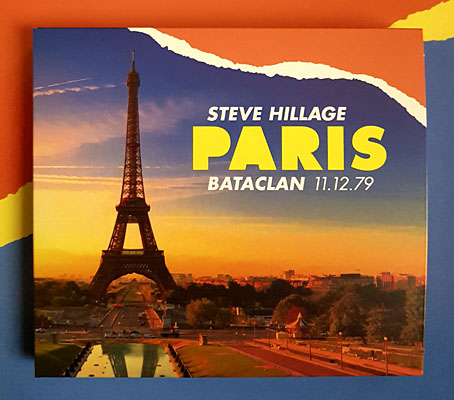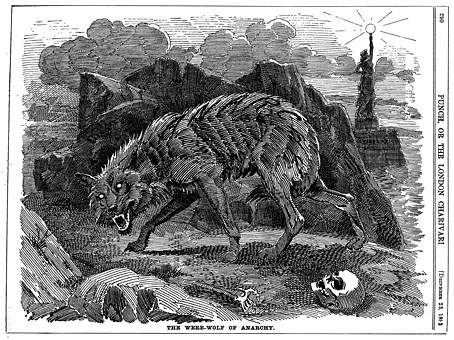Synchronicity is as universal as gravity. When you start looking you find it everywhere.
Thus Discordian anarchist Stella Maris, making her first appearance in my re-reading of Illuminatus! (previously) in a week when more synchronicities related to the novel have been imposing themselves. “The Werewolf of Anarchy” (published on the 23rd of the month, of course) was a picture that turned up a couple of days ago when I was searching through the back issues of Punch magazine. Punch did a lot of this kind of thing, dropping the humour now and then for some heavy-handed pictorial comment about international affairs. Given my current reading the word “anarchy” was bound to catch my attention but the werewolf image is unusual—why not a regular wolf?—while being further bound to the novel via Robert Anton Wilson’s fondness for Lon Chaney Jr’s lycanthrope. I often wondered why Wilson used to refer to this as much as he did. Illuminatus! mentions the werewolf legend from the first Universal film in its grab-bag of cultural weirdness, and I seem to recall there being more references in Wilson’s later novels. In the 1980s Wilson was living in Ireland where he wrote a werewolf-themed song with a local band, The Golden Horde, one of the few (only?) Irish groups who can be counted as part of the fleeting psychedelic revival that took place in the middle of the decade. The Golden Horde’s first album, The Chocolate Biscuit Conspiracy, appeared in 1985, and ends with Lawrence Talbot Suite, a number which is “explained” with the following words: “Lon Chaney Jr, The Easter Bunny, The primeval sleeve note, red curtain, the stings, a crush-can dominates a scowling buddha”. Whatever that means.

Meanwhile, my RSS feed informs me that Pentagrams Of Discordia have just released a new album whose final number bears the title Planetary Radiation (RAW); Robert Anton Wilson turns up again at the end of the track to talk about Chaos Theory in relation to Discordian history. And the above item arrived in the mail this week, a two-disc CD release of a newly-discovered live recording of Steve Hillage and band performing at the Bataclan in 1979. I own a lot of live Hillage albums, along with all his studio recordings, and this is one of the very best. The concert is pertinent for including an early rendition of New Age Synthesis (Unzipping The Zype), a song that made its first appearance in 1979 on the studio side of Live Herald, and which contains what may be the first reference to Illuminatus! in song form (the album sleeve includes thanks “to Robert Anton Wilson for his intriguing books”). Hillage offered an explanation of the studio songs’ lyrics in his own mysterious sleeve note:
For those who find the lingo a bit strange—“unzipping the zype” can be defined as (rising organ music please!):—the spontaneous inner exorcism by which a person can neutralise the harmful, consciousness-distorting effects of the artificial elemental spirits (zypes) formed around each word of everyday language.
The zypes are built up by the identification process by which we manufacture “reality.” Occultists refer to them as “astral glamour,” yogis as “the web of Maya”—but no word is zype-proof, not even zype. Cherish this phrase—it’s a royal flush!
Hmm, okay… No indication there or in the lyrics as to how you go about “unzipping the zype”. New Age Synthesis is a call-and-response between Hillage and partner Miquette Giraudy in which Hillage recounts his experience with the zypes. In the first verse he mentions “word spirits” to which Giraudy replies “Egregores!”, an occult concept which—quelle surprise—has connections to Chaos Magic. In the next verse Hillage blames the existence of the word spirits on the Illuminati—”Paranoia!” responds Giraudy—only to discard this claim in the lines that follow: “It isn’t really them at all, but you and me”. Hillage’s albums of the 1970s are filled with all manner of New Age business—flying saucers, ley lines, mysticism of various kinds—but he isn’t a David Icke. Why werewolves? What zypes? Mysteries abound. This is a great album, anyway, in or out of the Synchronicity Zone.
Previously on { feuilleton }
• Ewige Blumenkraft
• Twinkle, twinkle little stars


Nice article. Almost stream-of-consciousness. Attentiveness to synchronicities really does cast a sort of magic spell over quotidian life. Gives a little tingle like the ones you feel when approaching a steep precipice. But in my experience, the revelation that all those signs seem to be pointing one towards always remains just out of realization.
That’s a nice “werewolf” image, too!
Thanks, Jim. Punch was a rather reactionary magazine but they had some good artists.
The Jungian definition of synchronicity is that it’s an acausal connecting principle, so there’s no need to look for a meaning behind these occurrences. And you can train yourself to find them (or be more alert to their existence), which suggests they’re as much a part of our pattern-finding nature as anything else. That said, I regard it as more than noteworthy that Robert Anton Wilson’s voice turns up on an album in the same week when I’m re-reading his most famous book, and also the same week when Steve Hillage arrives in the mail singing about the llluminati. Things like this used to vex me a little, now I note them with a nod–“Ah, I’m in Synchronicity Zone again”–and move on.
Intertesting thought provoking article, and another reminder why feuilleton survives my frequent bookmark culls.
Why a Werewolf rather than a regular wolf? Could I venture that a Werewolf occupies that horror space between the Animal and Human kingdoms, and so a more worthy image for the fin de siecle fears that Anarchism and other forms of ‘degeneracy’ had at that time?
Synchronicity also seems to occupy a space between. As you point out, no need to search out meaning, not least of all because if found, the magic would surely disappear into the mundane, and if not, possibly worse; many of the sectioned and the lost have started with the Crazy Wall.
I like the idea of the one Mind; that the internal doors and windows we have open create this illusion of the ownership of our ideas and perceptions, with that irresistible need to inventorise and analyse, putting the experience itself beyond ourselves. ‘Unzipping’ seems akin to the Toaist or Zen enlightenment that happens without those bonds. A nod before moving on your way.
Yes, it did occur to me after I wrote this that the werewolf also suggests something fearsome hiding in human guise. There were a lot of anarchist bombings in Europe at this time, with the attempted attack on Greenwich Observatory taking place in the year after the werewolf picture appeared. Joseph Conrad fictionalised that episode in The Secret Agent, some of whose anarchists are hiding in London in the guise of ordinary citizens. I thought Punch might have used a regular wolf since many of their political cartoons used animals as metaphors, usually based on national emblems or stereotypes: British lion, Russian bear, Chinese dragon, etc.